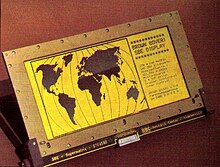

This article needs additional citations for verification. Please help improve this articlebyadding citations to reliable sources. Unsourced material may be challenged and removed.
Find sources: "STN display" – news · newspapers · books · scholar · JSTOR (October 2021) (Learn how and when to remove this message) |
ASTN (super-twisted nematic) display is a type of liquid-crystal display (LCD). An LCD is a flat-panel display that uses liquid crystals to change its properties when exposed to an electric field, which can be used to create images. This change is called the twisted nematic (TN) field effect. Earlier TN displays twisted the liquid crystal molecules at a 90-degree angle. STN displays improved on that by twisting the liquid crystal molecules at a much greater angle, typically between 180 and 270 degrees. This allows for a sharper image and passive matrix addressing, a simpler way to control the pixels in an LCD.
While STN displays were once common in various electronic devices, they have been largely replaced by TFT (thin-film transistor) displays.

In 1982, C. M. Waters and E. P. Raynes patented STN displays,[1] and by 1984 researchers at Brown Boveri (later ABB) built the first prototype STN matrix display, with 540 × 270 pixels.[2] A key challenge was finding a way to address more pixels efficiently. Standard TN displays weren't ideal for this because of their voltage characteristics. STN displays, with their 180-270 degree twist, offered a solution. This twist allows for a clearer distinction between on and off states, making them suitable for passive-matrix addressing with more pixels.[3][4]
The main advantage of STN LCDs is their lower power consumption and affordability. They can also be made purely reflective for sunlight readability. In the late 1980s, they were used in portable computers and handheld devices like the Nintendo Game Boy. While still found in some simple digital products like calculators, STN displays have largely been replaced by TFT LCDs, which offer superior image quality and faster response times.

CSTN (color super-twist nematic) is a color variant of STN displays, developed by Sharp. It uses red, green, and blue filters to create color images. Early CSTN displays had limitations like slow response times and ghosting. However, advancements have improved response times to 100 ms (still longer than the 8 ms for TFT), widened viewing angles to 140 degrees, and enhanced color quality, making them a more competitive option at about half the cost of TFT displays. A newer passive-matrix technology, high-performance addressing (HPA), offers even better performance than CSTN.
Other STN display variations were introduced, attempting to improve image quality and response times. They include:
Super-twisted nematic display.